Bhushan B. Nanotribology and Nanomechanics: An Introduction
Подождите немного. Документ загружается.

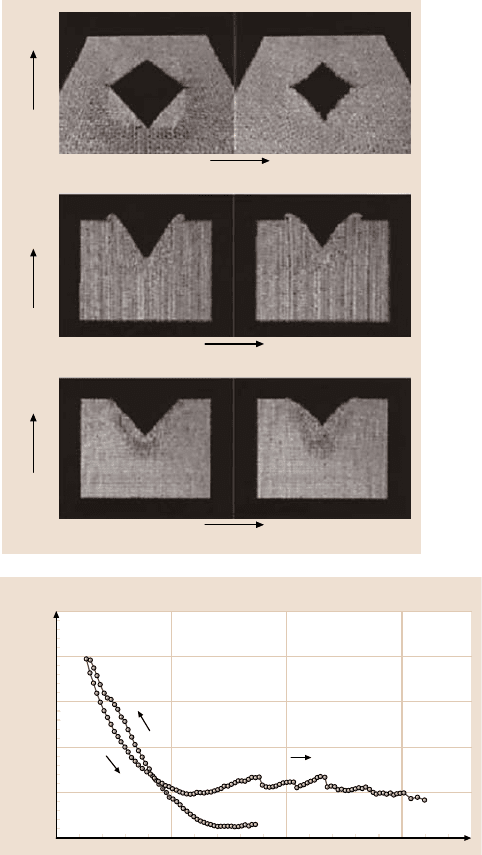
13 Computer Simulations of Nanometer-Scale Indentation and Friction 677
[1
21
0]
[101
0]
[0001]
[0001]
[013
0]
[101
0]
a)
b)
c)
Fig. 13.15. Snapshots of the
silicon nitride (a) surface,
(b) slide parallel to the edges
of the indenter, and (c) slide
across the indenter diago-
nal. The left-hand side shows
the surface when it is fully
loaded, while the right-hand
side shows the surface after
the tip has been withdrawn.
After [148] with the permis-
sion of the AIOP (2003)
6700
Potential energy (eV)
6600
6500
6400
6300
6200
Fig. 13.16. Potential energy as a function of rigid-layer separation generated from an MD
simulation of an elastic (nonadhesive) indentation of a hydrogen-terminated diamond (111)
surface using a hydrogen-terminated, sp
3
-hybridized tip. After [149] with the permission of
Elsevier (1992)
retracted. Not surprisingly, when the surface is bare and not terminated with hydro-
gen atoms, the repulsive interactions between the tip and the surface are minimized
and the tip indents the substrate without twisting [149]. Because carbon–carbon
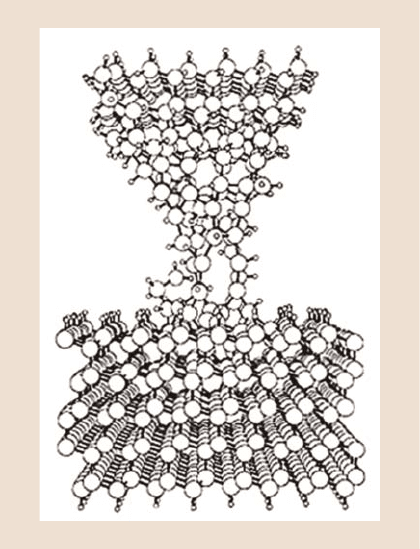
678 Susan B. Sinnott et al.
Fig. 13.17. Illustration of
atoms in the MD simulat-
ion of the indentation of
a hydrogen-terminated dia-
mond (111) substrate with
a hydrogen-terminated, sp
3
-
hybridized tip at selected time
intervals. The figure illustrates
the tip–substrate system as the
tip was being withdrawn from
the sample. Large and small
spheres represent carbon and
hydrogen atoms, respectively.
After [149] with the permis-
sion of Elsevier (1992)
bonds are formed between the tip and the first layer of the substrate, the indentation
is ordered (the surface is not disrupted as much by interacting with the tip) and the
eventual fracture of the tip during retraction results in minimal damage to the sub-
strate. The concerted fracture of all bonds in the tip gives rise to a single maximum
in the potential versus distance curve at large distances.
Harrison et al. [152,153] and Garg et al. [151,154] considered the indentation
of hydrogen-terminated diamond and graphene surfaces with AFM tips of carbon
nanotubes and nanotube bundles using MD simulations and bond-order potentials.
Tips consisting of both single-wall nanotubes and multiwall nanotubes were con-
sidered. The simulations predicted that nanotubes do not plastically deform during
tip crashes on these surfaces. Rather, they elastically deform, buckle, and slip as
shown in Fig. 13.18. However, as is the case for diamond tips indenting reactive di-
amond surfaces discussed above, strong adhesion can occur between the nanotube
and the surface that destroys the nanotube in the case of highly reactive surfaces, as
illustrated in Fig. 13.19.
To summarize, MD simulations reveal the properties of ceramic tips and sur-
faces with covalent or ceramic bonding that are most importantfor nanometer-scale
indentation. They predict that brittle fracture of the tip can occur that is sometimes
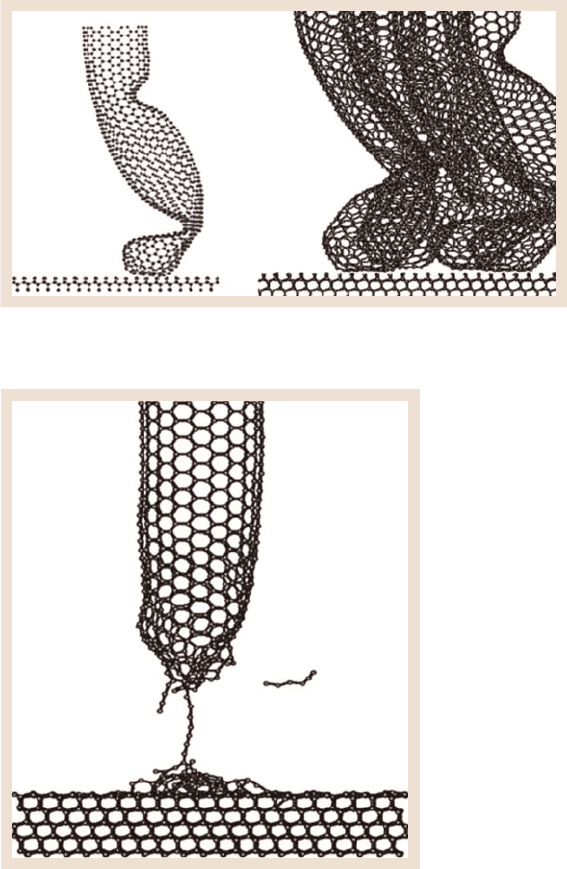
13 Computer Simulations of Nanometer-Scale Indentation and Friction 679
Fig. 13.18. Snapshots of the indentation of a single-wall nanotube (left-hand image)and
a bundle of nanotubes (right-hand image) on hydrogen-terminated diamond (111)
Fig. 13.19. Snapshot of
a single-wall carbon nano-
tube as it is withdrawn fol-
lowing indentation on a bare
diamond (111) surface. Af-
ter [151] with the permission
of APS (1999)
accompanied by strong adhesion with the surface. They also reveal the conditions
under which neither the tip nor the surface is affected by the nanoindentation pro-
cess. The insight gained from these simulations helps in the interpretation of ex-
perimental data, and it also reveals the nanometer-scale mechanisms by which, for
example, tip buckling and permanent modification of the surface occur.
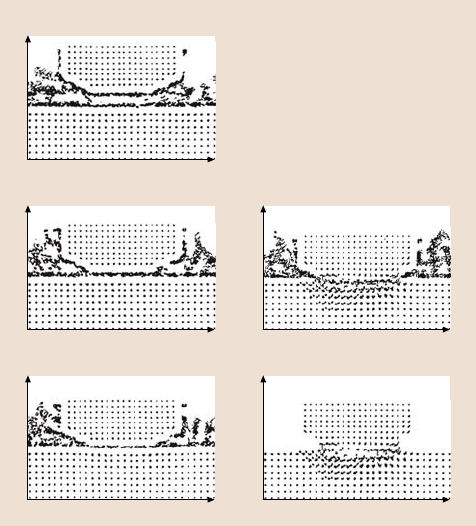
680 Susan B. Sinnott et al.
13.3.2 Thin Films
In many instances, surfaces are covered with thin films that can range in thickness
from a few atomic layers to several µm. These films are more likely to have proper-
ties that differ from the properties of bulk materials of similar composition, and the
likelihood of this increases as the film thickness decreases. Nanoindentation is one
of the best approaches to determining the properties of these films. Consequently,
numerous computational simulations of this process have been carried out.
For example, MD simulations have been used to study the indentation of metal
surfaces covered with liquid n-hexadecane films, as illustrated in Fig. 13.20. As
the metal tip touches the film, some of the molecules from the surface transfer to
the tip and this causes the film to “swell”. As the tip continues to push against
the surface, the hydrocarbon film wets the side of the tip. The simulations show
how the hydrocarbon film passivates the surface and prevents the strong attractive
interactions discussed above for clean metal surfaces and tips from occurring.
In a series of MD simulations, Tupper and Brenner modeled the compression
of a thiol self-assembled monolayer (SAM) on a rigid gold surface using both
z
x
c)
z
x
e)
z
x
b)
z
x
d)
z
x
a)
Fig. 13.20a–e. Cutaways of the side view from molecular dynamics simulations of a Ni tip
indenting a Au (001) surface covered with a hexadecane film. In (e) only the metal atoms are
shown. Note how the hexadecane is forced out from between the metal surfaces. After [110]
with the permission of Elsevier (1995)
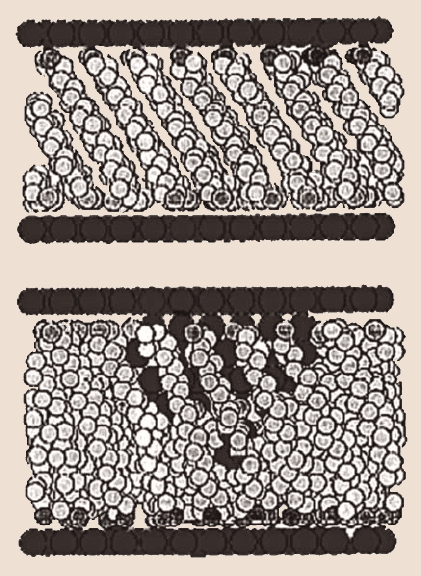
13 Computer Simulations of Nanometer-Scale Indentation and Friction 681
a smooth compressing surface [155] and a compressing surface with an asper-
ity [156]. These simulations showed that compression with the smooth surface pro-
duced a compression-induced structural change that led to a change in slope of the
simulated force versus compression curve. This transition is reversible and involves
a change in the ordered arrangement of the sulfur head groups on the gold surface.
A similar change in slope seemed to be present in the experimental indentation
curves of Houston and coworkers [157], but was not discussed by the authors. The
simulations with the asperity showed that the asperity is able to penetrate the tail
groups of the SAM, as illustrated in Fig. 13.21, before an appreciable load is appar-
ent on the compressing surface. This result indicates that it is possible to image the
head groups of a thiol self-assembled monolayer that are adsorbed onto the surface
of a gold substrate using STM, and consequently ordered images of these systems
may not be indicative of the arrangement of the tail groups.
Zhang et al. [158] used a hybrid MD simulation approach, where a dynamic
element model for the AFM cantilever was merged with a MD relaxation approach
for the rest of the system, to study the frictional properties of alkanethiol SAMs
on gold. They investigated the effect of several variables like chain length, terminal
group, scan direction, and scan velocity. Their results show that friction forces de-
crease as the chain length of the SAMs increase. In the case of shorter chains such
Fig. 13.21. Snapshots illus-
trating the compression of
a self-assembled thiol film
on gold for a smooth surface
(top) and a surface contain-
ing an asperity (bottom). The
asperity can penetrate and
disorder the film tail groups
before appreciable load oc-
curs
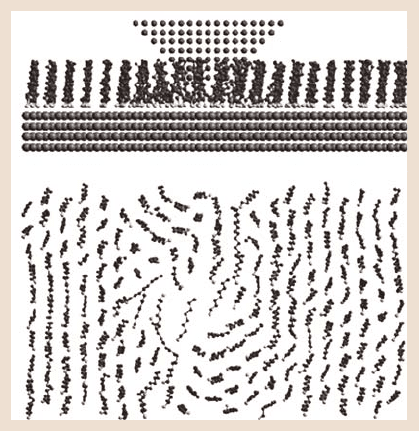
682 Susan B. Sinnott et al.
as C
7
CH
3
, the SAMs near the tip can be deformed by indentation, as illustrated in
Fig. 13.22. This behavior is predicted to be the cause of higher friction that occurs
for the short-length chains.
Harrison and coworkers have used classical MD simulations [153,159] to ex-
amine the indentation of monolayers composed of linear hydrocarbon chains that
are chemically bound (or anchored) to a diamond substrate. Both flexible and rigid
single-wall,capped nanotubeswere usedas tips.The simulationsshowedthat inden-
tation causes the ordering of the monolayer to be disrupted regardless of the type of
tip used. Indentation results in the formationof gauche defects within the monolayer
and, for deep indents, results in the pinning of selected hydrocarbon chains beneath
the tube. Flexible nanotubes tilt slightly as they begin to indent the softer mono-
layers. This small distortion is due to the fact that nanotubes are stiff along their
axial direction and more flexible in the transverse direction. In contrast, when the
nanotubesencounter the hard diamondsubstrate, after “pushing”through the mono-
layer, they buckle. This process is illustrated in Fig. 13.23 and the force curves are
shown in Fig. 13.24. The buckling of the nanotube was previously observed when
single-wall, capped nanotubes were brought into contact with hydrogen-terminated
diamond (111) surfaces [151,152]. In the absence of the monolayer, the nanotube
tips encounter the hard substrate in an almost vertical position. This interaction with
the diamond substrate causes the cap of the nanotubes to be “pushed” inside the
nanotube (they invert). Increasing the load on the nanotubes causes the walls of the
tube to buckle. Both the cap inversion and the buckling are reversible processes.
That is, when the load on the tube is removed, it recovers its original shape.
a)
b)
Fig. 13.22. (a)Sideand
(b) top views of the final
configuration of a C
7
CH
3
self-assembled monolayer on
Au (111) under a high normal
load of 1.2 nN at 300 K. The
tip is not shown in (b)for
clarity. After [158] with the
permission of the ACS (2003)
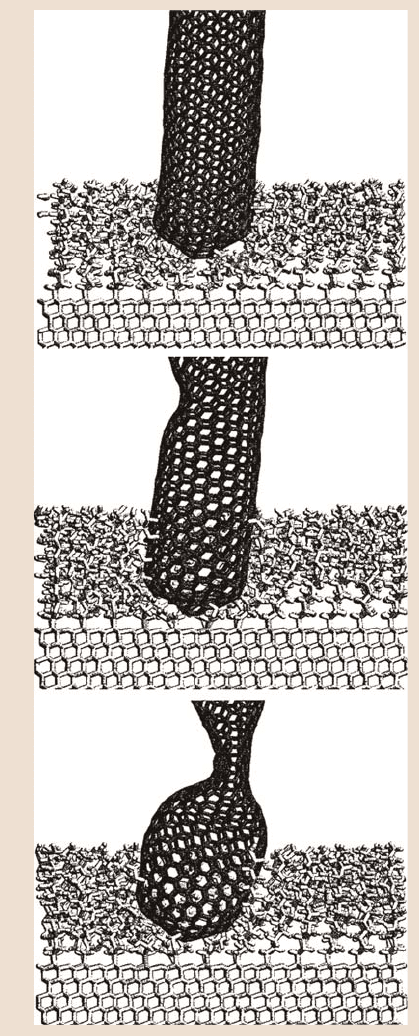
13 Computer Simulations of Nanometer-Scale Indentation and Friction 683
a)
b)
c)
Fig. 13.23a–c. Snapshots
from the simulation of the in-
teraction of a flexible single-
walled carbon nanotube with
a monolayer of C
13
chains
on diamond. The loads are
(a)19.8nN,(b)41.2nN,and
(c)36.0 nN. After [159] with
the permission of the ACS
(2003)
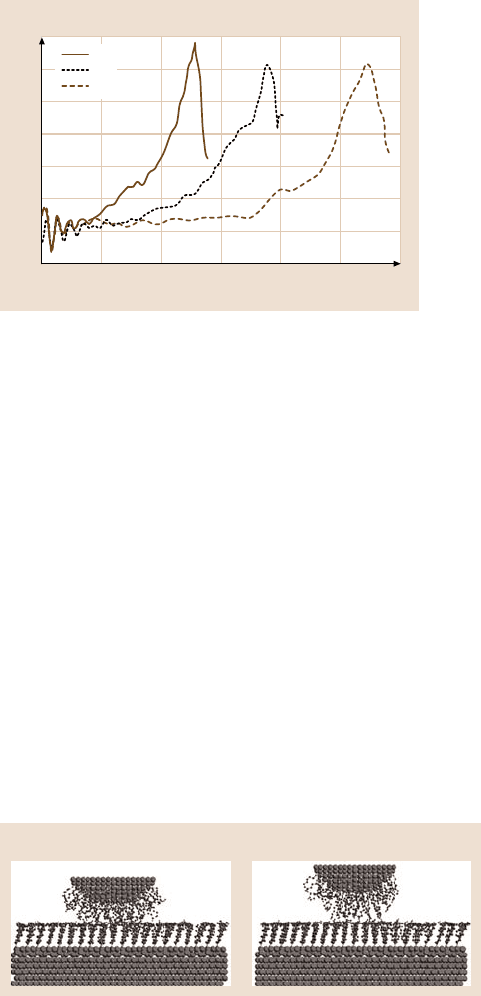
684 Susan B. Sinnott et al.
0
10
Indent time (ps)
F
z
(nN)
0
10
20
30
40
50
60
305 10 15 20 25
C
8
C
13
C
22
Fig. 13.24. The load on
the upper two layers of the
flexible carbon nanotube in-
denter shown in Fig. 13.23
as a function of indentation
time for the nanoindentation
of the indicated hydrocarbon
monolayes on diamond. Af-
ter [159] with the permission
of the ACS (1999)
Deep indents of the hydrocarbon monolayers using rigid nanotubes result in
rupture of chemical bonds. The simulations also show that the number of gauche
defects generated by the indentation is a linear function of penetration depth and
equal for C
13
and C
22
monolayers. Thus, it is the tip that governs the number of
gauche defects generated.
Leng and Jiang[160]investigatedthe effect of using tips coated with SAMs con-
taining hydrophobicmethyl (CH
3
) or hydrophilichydroxyl (OH) terminal groups to
nanoindent gold surfaces that also are covered with SAMs with the identical termi-
nal groups as the tip. Figure 13.25 contains snapshots for the indentation process
predicted to occur for terminal OH/OH interactions during compression and the
pull-off. The adhesion force of OH/OH pairs is calculated to be about four times
larger than that of CH
3
/CH
3
pairs, as shown in Fig. 13.26. This is due to the forma-
tion of hydrogen bonding between OH/OH pairs. This interaction is also expected
to increase the frictional force between monolayers with OH terminations.
Related MD simulations by Mate predict that the end groups on polymer lubri-
cants have a significant influence on the lubrication properties of polymers [161].
For instance, fluorinated end groups are predicted to be less reactive than regular
alcohol end groups. When fluorinated films are indented, the normal force becomes
a)
Compression
b)
Pull-off
Fig. 13.25. Snapshots from the OH/OH pair interaction during (a) compression and (b) pull-
off. After [160] with permission of the ACS (2002)
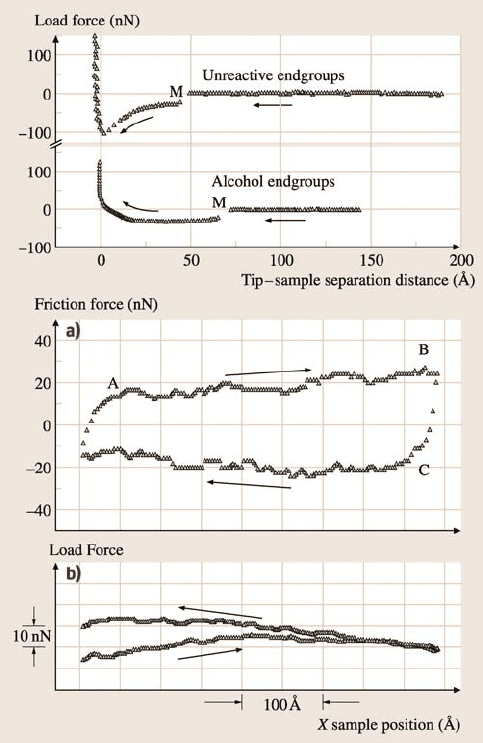
13 Computer Simulations of Nanometer-Scale Indentation and Friction 685
Fig. 13.26. Top: The force versus distance curve (indentation part only) for unbonded per-
fluoropolyether on Si (100). The unreactive end groups were from a 10 Å-thick film; the
reactive alcohol end groups were from a 30 Å-thick film. The negative forces represent at-
tractive interactions between the tip and the surface. Bottom: Measured plots of friction and
load forces of the tip as it slides over the sample with the alcohol end groups. After [161]
with the permission of the APS (1992)
more attractive as the distance between the tip and film decreases until the hard wall
limit is reached and the interactions become repulsive. In contrast, when AFM tips
indent hydrogenated films, the forces become increasingly repulsive as the distance
between them decreases, as shown in Fig. 13.27 and Fig. 13.28. This predicted be-
havior is due to the compression of the end group beneath the tip. For the lubricant
molecules to be squeezed out from between the tip and the surface, the hydrogen
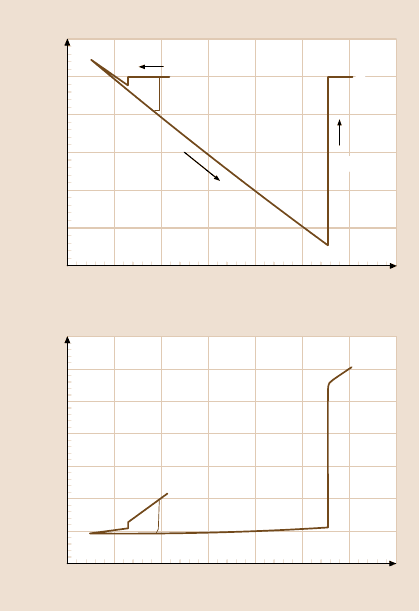
686 Susan B. Sinnott et al.
20
20
z
M
(Å)
z
i
(Å)
0
20
40
60
80
100
120
b)
1200 20406080100
OH OH
CH
3
CH
3
a
d
b
c
e
OH/OH
20
5
z
M
(Å)
F
z
(nN)
1
a)
1200 20406080100
a
d
b
c
CH
3
/CH
3
4
3
2
1
0
e
Fig. 13.27. (a) Force–
distance curves and (b) tip
position (z
i
) versus sup-
port position (z
M
)forthe
OH/OH contact pair and the
CH
3
/CH
3
contact pair. Af-
ter [160] with the permission
of the ACS (2002)
bonding between the two must first be broken and this increases the force needed to
indent the system. As a result, a major effect of the presence of alcohol end groups
is to dramatically increase the load that a liquid lubricant can support before failure
(solid–solid contact) occurs.
When atomically sharp tips are used to indent solid-state thin films where there
is a large mismatch in the mechanical properties of the film and the substrate, it
is difficult to determine the true contact area between the tip and the surface dur-
ing nanoindentation. In the case of soft films on hard substrates, pile-up can occur
around the tip that effectively increases the contact area. In contrast, with hard films
on soft substrates, “sink-in” is experienced around the tip that decreases the true
contact area.
A class of coatings that has received much attention is diamond-like amorphous
carbon (DLC) coatings. DLC coatings are almost as hard as crystalline diamond
and may have very low friction coefficients (< 0.01) depending upon the growth
conditions [162–165]. They have therefore generated much interest in the tribologi-
cal community and there have been several MD simulation studies to determine the
